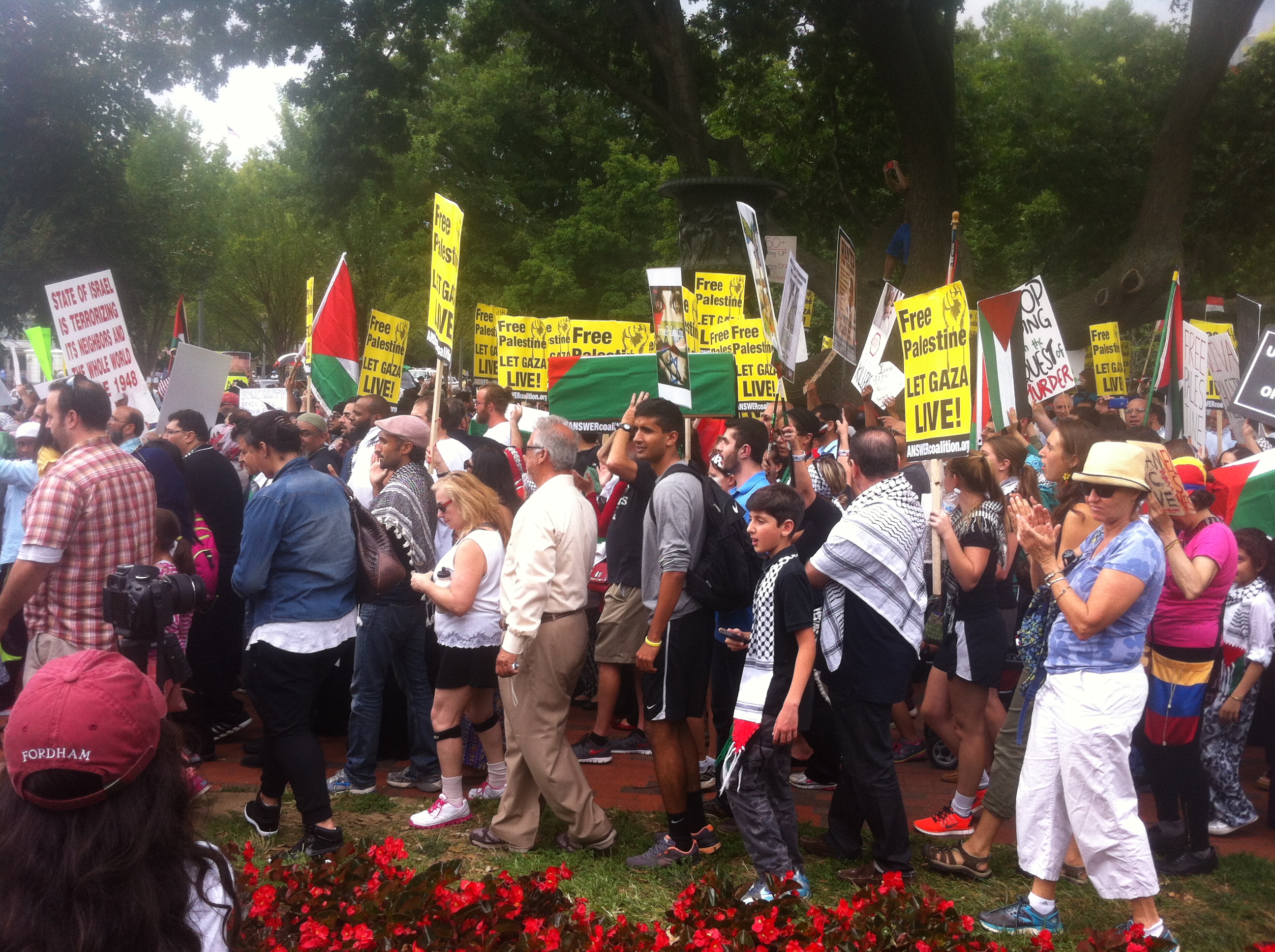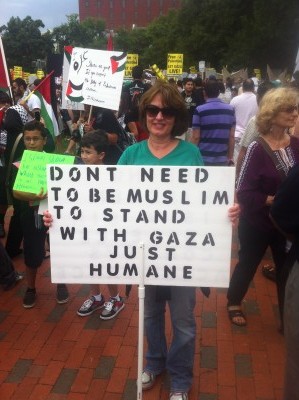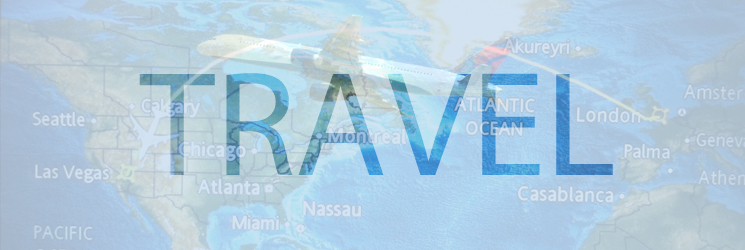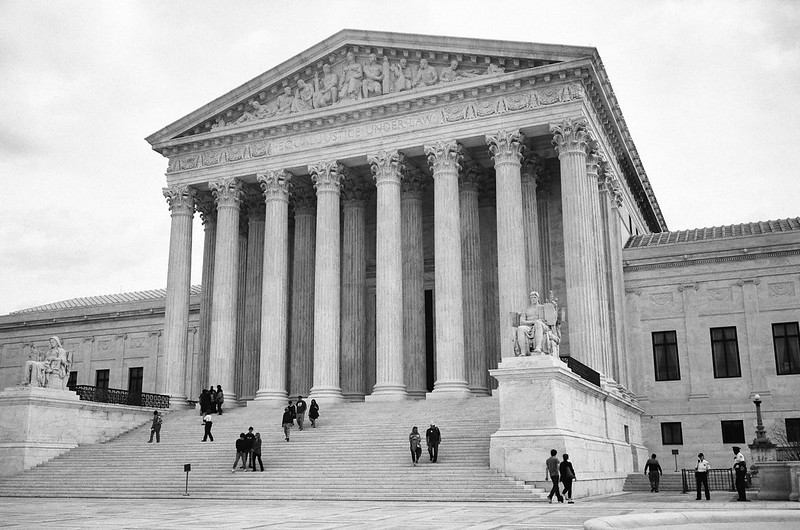I’m not one for humid, oppressively hot weather, but there I was standing on the grassy knoll opposite the White House, squinting into the noon-day sun. And I wasn’t alone. Roughly 10,000 people–give or take a few hundred—milled around me on Lafayette Square, spilling onto Pennsylvania Avenue.
My husband and I had driven two and a half hours from South Jersey to Washington D.C. to join these American men, women and children protesting against Israel’s deadly attacks on Gaza. This being my first march, I swiveled my head and craned my neck, eager to take in the every color and sound of the sea of demonstrators around me.
The throng began its mile long march, signs bobbing above protestors’ heads and child-sized cardboard coffins draped with Palestinian flags hoisted on men’s shoulders. A petite woman in a black abaya, heavily pregnant, walked past me. She was marching for Shayma al-Sheikh Qanan, the 23-year-old woman, eight months pregnant who was killed by an Israeli airstrike in central Gaza. An hour after Shayma took her last broken breath, doctors delivered a premature baby girl via an emergency C-section; the baby, also named Shayma, was hailed as Gaza’s “miracle baby,” a symbol of life refusing to be snuffed out no matter the horror around it. After five short days of fighting to survive, little Shayma succumbed to death when Israeli shelling knocked out Gaza’s only power station, shutting down incubators in the hospital’s intensive care unit. The pregnant woman beside me, one hand protectively placed on her burgeoning belly, walked purposefully for Shayma and baby Shayma.
Another mother, this one with all-American blond hair and blue eyes, caught my eye. She walked slowly so her three children, all less than ten-years-old, could keep pace with her. She and her brood were marching for Wejdan Abu Shammala, a Palestinian woman born and raised in a refugee camp who tucks her three children, two, four and six-years-old, into bed with her and her husband one night, hoping to increase the odds of survival if an Israeli shell hits one of the empty bedrooms, and into different beds the next night so not all three will die in an attack. All the while she performs these painful contortions, she knows she will have to live with the consequences of one ill-fated move. The American mother with her children in tow marched for Wejdan and her children, Maryam, Rami and Hasan.

In front of me strode a college student with the familiar Keffiyeh draped across her shoulders–a patterned black-and-white scarf symbolizing solidarity with Palestinian’s struggle for autonomy and statehood. Her small, slender build belied a booming voice that led those around her in a rhythmic chant: “Free, free Palestine, killing children is a crime!” She was walking for Asma Ghabin. Three days earlier Israel had unleased heavy artillery—a category of weapon not designed for precision use in densely populated urban areas–on a United Nations school in Jabliya that was sheltering displaced Palestinians. The attack killed 21 civilians, most of them children. Asma was among the injured, but having nowhere else to go, she lay down with her two toddler sons on a thin, raggedly mattress in the exact same spot where she had been pierced in the thigh by shrapnel less than a day ago. The spirited young woman in front of me marched for Asma.
Seeing these determined individuals, some of whom had traveled from as far as Florida, Chicago and Ohio, bolstered my lagging morale. It might seem counter-intuitive to believe that Israel should no longer count on U.S. support for its policies as assuredly as it has in the past; after all, hadn’t the Senate just unanimously passed, not one, but two resolutions declaring its unequivocal support of Israel’s attacks on Gaza? Still, we all had reason to believe the tide was turning. A new Pew Research Center Poll revealed a huge generational split on the current conflict in Gaza: people 30 years or older point the finger at Hamas as the party most responsible for the violence, but 18 to 29-year olds buck this trend, with the majority of them placing the lion’s share of the blame on Israel. I could see these poll numbers in play at the rally. Most of the middle-aged or elderly protesters were of Middle Eastern descent, but the young adults appeared to be a solid mix of both white and Middle Eastern Americans.
.jpg)
I eavesdropped on clusters of 20 somethings talking about the Palestinian-Israeli conflict and heard language typically not used in American media and culture—“colonialism” and “apartheid.” For nearly half a century, the horrifying reality of the Holocaust had obscured the narrative of the gradual dispossession of the Palestinian people. Yet, now it seemed that as the history of World War II retreats from the public square into the history books, “Remember Auschwitz” can no longer be invoked to justify cruelty in another time and place. The young Americans marching alongside me had grown up well past the postwar era and saw what was happening in Gaza not as survival tactics on the part of Israel, but rather as brutal colonial ones. The narrative of the Palestinian people’s dispossession was displacing—albeit slowly– that of Israel’s victimhood.
A few of the protestors mentioned that a small group of pro-Israel demonstrators had briefly made an appearance, condemning the march as anti-Semitic. Uniformed Secret Service agents and local police, some on horseback, had immediately swelled to prevent a physical altercation between the two competing groups, but they need not have been worried because the two dozen or so pro-Israeli demonstrators quickly dispersed. None of the protestors seems surprised by the accusations of anti-Semitism; it seems that shorn of all other justifications for its behavior, Israel and its supporters today fall back with increasing shrillness upon the oldest defense of all: those who disagree with Israel’s treatment of Palestinians are simply anti-Semitic. This trump card has been played more aggressively in recent years because it is now the only one left in the deck.

As we rounded the last block and made our way back to Lafayette Square, I felt triumphant—burning blisters and all. We had brought traffic to a stand-still in the area, but drivers didn’t seem at all irked by our rally, many of them even flashing peace signs from open car windows. I didn’t expect Obama to do an about-face when it came to America’s foreign policy, but 10,000 people had joined together and made a point—that Shayma, Wejdan and Asma deserve life, statehood and peace.
Zehra Rizavi is the Managing Editor of altMuslimah




